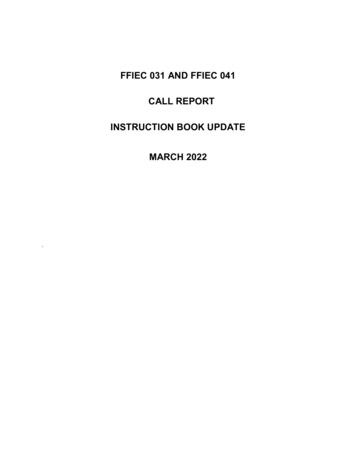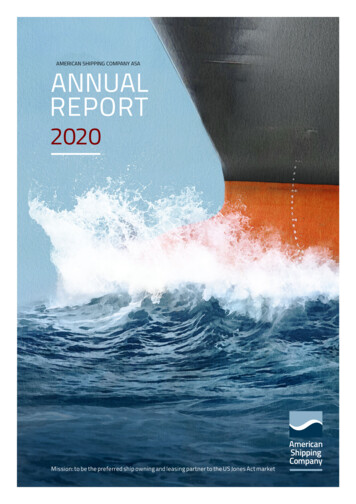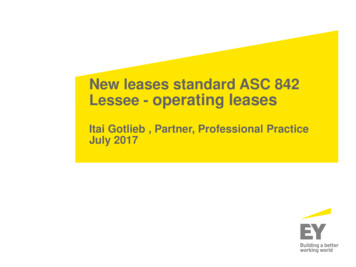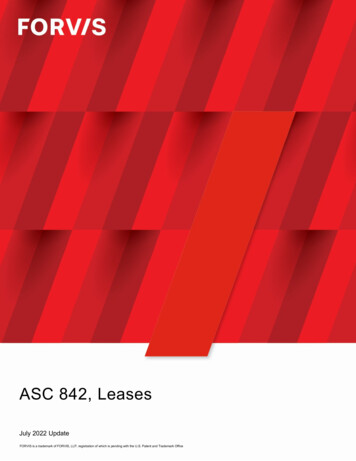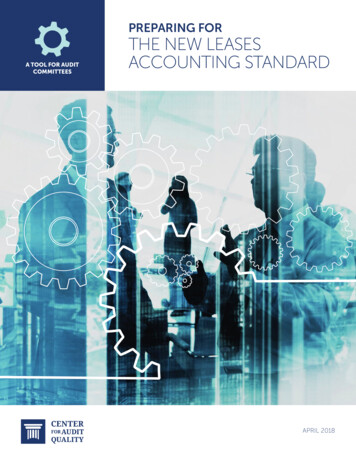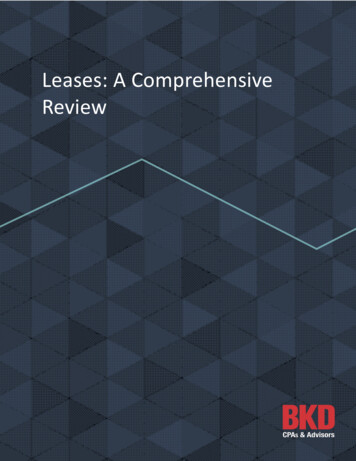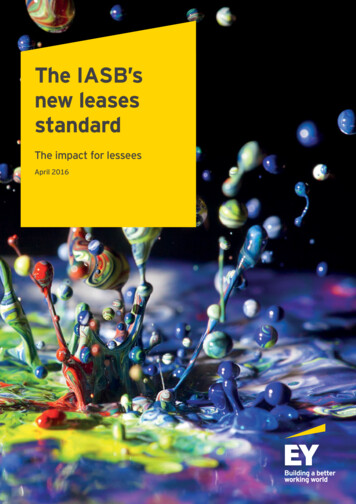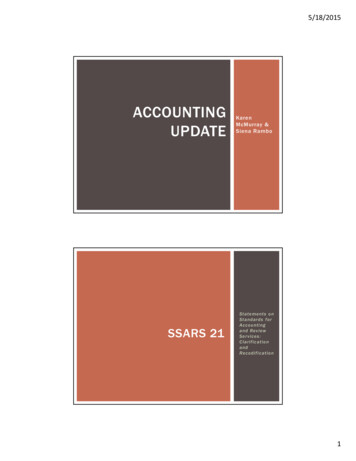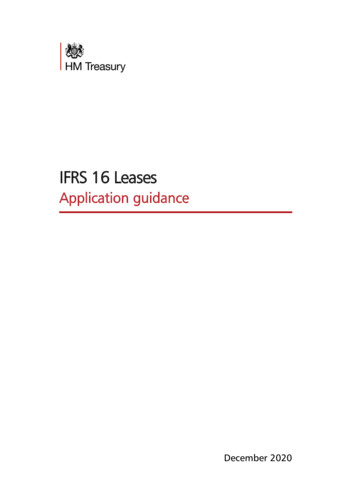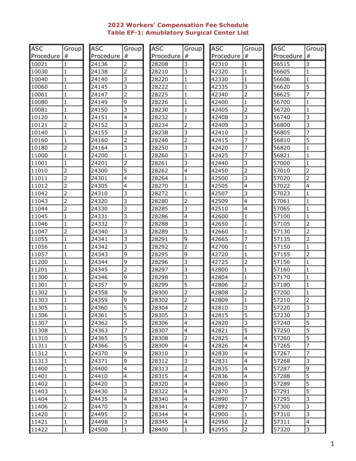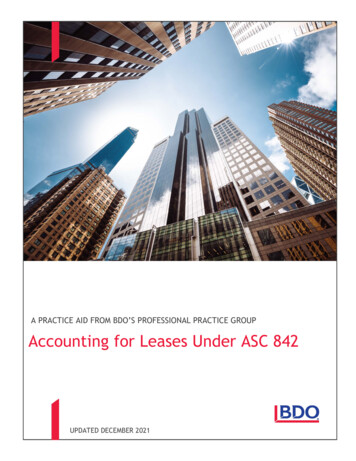
Transcription
ACCOUNTING FOR LEASES UNDER ASC 842A PRACTICE AID FROM BDO’S PROFESSIONAL PRACTICE GROUPAccounting for Leases Under ASC 842UPDATED DECEMBER 20211
ACCOUNTING FOR LEASES UNDER ASC 8422Table of ContentsINTRODUCTION . 5ASC 842 in a Nutshell . 6Lease Classification . 7Lessee Accounting. 8Lessor Accounting . 9Adoption Dates . 10About the Practice Aid . 10CHAPTER 1 - SCOPE OF ASC 842 . 12Scope and Scope Exceptions . 12Specific Considerations for Land Easements . 14Interaction with Other Standards . 17CHAPTER 2 - IDENTIFYING A LEASE . 18Overview. 18Identified Asset . 20Right to Control Use of Identified Asset . 27Other Illustrations . 42CHAPTER 3 - IDENTIFYING AND SEPARATING COMPONENTS . 48Overview. 48Identifying Lease and Nonlease Components . 52Separating Components - Lessees . 60Separating Components - Lessors . 69Portfolio Approach . 80Contract Combination . 80CHAPTER 4 - LEASE CLASSIFICATION AND KEY TERMS . 81Overview. 81Commencement Date . 84Lease Term . 89Lease Payments . 95Initial Direct Costs . 101Discount Rate . 102Economic Life . 106Fair Value. 106Lease Classification . 107
ACCOUNTING FOR LEASES UNDER ASC 8423CHAPTER 5 - ACCOUNTING FOR LEASES – LESSEES . 111Overview.Lease Classification by Lessees .Summary Accounting Requirements Based on Lease Classification .Short-Term Leases .Recognition and Initial Measurement .Subsequent Measurement .Remeasurements .Variable Lease Payments that Depend on an Index or a Rate.Modifications .Impairment .Derecognition .111112113114119123130137139152158CHAPTER 6 - ACCOUNTING FOR LEASES – LESSORS . 159Overview.Lease Classification by Lessors .Summary Accounting Requirements Based on Lease Classification .Sales-Type Leases – A Deeper Dive .Direct Financing Leases – A Deeper Dive .Operating leases.Modifications .Impairment .Other Transactions .159160161163176183185191195CHAPTER 7 - OTHER TOPICS . 196Overview.Sale and Leaseback Transactions .Business Combinations (or Acquisitions by Not-For-Profit Entities) .Subleases .Accounting for Income Taxes .196197227233238CHAPTER 8 - PRESENTATION AND DISCLOSURES . 242Overview. 242Presentation . 243Disclosure Requirements . 248CHAPTER 9 - ADOPTING ASC 842 . 256Overview.Effective Dates .Transition Methods .Transition Disclosures .Transition Practical Expedients .Transition – Lessees .Transition - Lessors .Other Transition Requirements .Application of the Portfolio Approach in Transition .256258260263264271282286289CONTACTS . 290
ACCOUNTING FOR LEASES UNDER ASC 842THIS PRACTICE AIDThe Practice Aid includes detailed guidance and flowcharts on analyzing and accounting for contracts underFinancial Accounting Standards Board (FASB) Accounting Standards Codification (ASC) 842, Leases. The graphicsand illustrations in this Practice Aid are provided to assist readers in understanding various aspects of the leaseaccounting guidance. Accounting for contracts may vary based on the specific facts and circumstances of eachcontract and therefore may differ from the illustrations provided in the Practice Aid.The Practice Aid focuses on the accounting for lease contracts under ASC 842 only. Additional information on theaccounting for leases under International Financial Reporting Standards (IFRS) is available here.4
ACCOUNTING FOR LEASES UNDER ASC 8425IntroductionIn February 2016, the Financial Accounting Standards Board (“FASB”) issued new lease accounting guidance in ASU2016-02, Leases (“ASC 842”). Under its core principle, a lessee recognizes a right-of-use (“ROU”) asset and a relatedlease liability on the balance sheet for most leases. The most significant change is on the balance sheet for lessees. Forthe income statement, the pattern of expense recognition depends on a lease’s classification but is generallyconsistent with current U.S. GAAP (ASC 840, Leases, or “ASC 840”).The objective for updating lease accounting was to increase transparency and comparability among entities byrecognizing lease assets and lease liabilities on the balance sheet by lessees for most leases and by disclosing keyinformation about leasing arrangements. This new guidance addressed stakeholder concerns that the previous leaseaccounting guidance did not result in a faithful representation of leasing transactions; specifically, that the rights andobligations associated with operating leases were not recognized on the balance sheet.Under ASC 840, lessees recognized capital leases on the balance sheet but only disclosed operating leases as off-balancesheet arrangements. There were no major differences in the accounting treatment for an operating lease versus a servicecontract. ASC 842 now changes that and, as such, the key determination will be whether a contract is or contains alease as that will drive whether a contract is recognized on the balance sheet.The leases project began as one of several joint projects between the FASB and the International Accounting StandardsBoard (IASB) aimed at converging U.S. GAAP and International Financial Reporting Standards (IFRS). However, afterseveral years of deliberations and two exposure drafts, the FASB and IASB reached different conclusions on variousaspects of lease accounting (such as classification of leases by lessees), and each of FASB and IASB issued separateguidance early in 2016. Additional information on the accounting for leases under IFRS is available here.
ACCOUNTING FOR LEASES UNDER ASC 842ASC 842 IN A NUTSHELLThe following flowchart summarizes at a high level what an entity considers when applying ASC 842, which we willexplore in further details throughout the Practice Aid.* Exceptions exist when a lessee or lessor elect a practical expedient not to separate nonlease component(s) from the associatedlease component (see Identifying and Separating Components).6
ACCOUNTING FOR LEASES UNDER ASC 842LEASE CLASSIFICATIONThe following flowchart summarizes classification of a lease by lessees and lessors under ASC 842 (after adoption ofASU 2021-05):7
ACCOUNTING FOR LEASES UNDER ASC 8428LESSEE ACCOUNTINGAs illustrated on the previous page, a lessee classifies a lease as either an operating lease or a finance lease usingclassification criteria that are generally consistent with ASC 840. The lease (whether operating or finance) isrecognized on balance sheet at the commencement date unless the practical expedient for short-term leases is elected(see below). The following table summarizes a lessee’s accounting for leases:Finance LeasesROU AssetBalanceSheetOperating LeasesLease LiabilityROU AssetLease LiabilityROU asset is initiallymeasured at the amountof the lease liability,plus initial direct costsand prepaid leasepayments, less leaseincentives received.Lease liability isinitially measured atthe present value ofthe unpaid leasepayments.Initial measurement is the same as for financeleases.Subsequently, ROU assetis typically amortized ona straight-line basis tothe earlier of the end ofits useful life or leaseterm. 1Subsequently, leaseliability is increased toreflect interest usingthe effective interestmethod and decreasedfor lease paymentsmade.Amortize based ondifference betweenperiodic straight-linelease cost (incl.amortization of initialdirect costs) andperiodic interestaccretion.Subsequentmeasurement is thesame as for financeleases.IncomeStatementRecognize amortization on ROU asset, interest onlease liability, and recognize variable leasepayments not included in the lease liability whenincurred. 2Recognize single lease cost (i.e., leasepayments plus initial direct costs) generally on astraight-line basis, and variable lease paymentsnot included in lease liability when incurred.2Cash FlowStatementClassify repayments of principal portion of leaseliability within financing activities and paymentsof interest on the lease liability and variable leasepayments within operating activities.Classify all cash payments for leases withinoperating activities.Once recognized on balance sheet, ASC 842 includes requirements for lessees to update the measurement of leases forcertain lease modifications and other reassessment events. Lessees will need robust processes and controls to timelyand completely identify and account for such events. When the lease liability is remeasured and the ROU assetadjusted, amortization of the ROU asset is adjusted prospectively from the date of remeasurement.The FASB also provided lessees with a practical expedient not to recognize short term leases on balance sheet. A shortterm lease is a lease with a lease term of 12 months or less and that does not include a lessee option to purchase theunderlying asset that is reasonably certain of exercise. This election is by asset class and, if elected, a lesseerecognizes lease payments on a straight-line basis over the lease term along with variable lease payments whenincurred, consistent with ASC 840.1If the lease transfers ownership of the underlying asset to the lessee or the lessee is reasonably certain to exercise an option to purchase theunderlying asset, the lessee amortizes the right-of-use asset to the end of the useful life of the underlying asset.2If the ROU asset is impaired under ASC 360, an impairment loss is also recognized. For operating leases only, recognition in the income statementpost-impairment no longer is on a straight-line basis (but still recognized as a single lease cost).
ACCOUNTING FOR LEASES UNDER ASC 8429LESSOR ACCOUNTINGLessor accounting remains largely consistent with ASC 840, and a lessor will continue to classify leases as either salestype, direct financing or operating leases. But lessor accounting has also been updated for consistency with the newlessee accounting model and with the new revenue standard in ASC 606, Revenue from Contracts with Customers (“ASC606”).The following table summarizes a lessor’s accounting for leases under ASC 842.BalanceSheetIncomeStatementSales-Type LeasesDirect Financing LeasesDerecognize underlying assetand recognize net investmentin the lease at commencementdate if collectability of leasepayments and lessee residualvalue guarantee is probable. 3Derecognize underlying assetand recognize net investmentin the lease (which includesselling profit and initial directcosts) at commencementdate.Continue to recognize underlyingasset.Recognize selling profit or loss.Recognize selling loss, if any.Recognize lease paymentsgenerally on a straight-line basisover the lease term if collectabilityis probable. Otherwise, leaseincome is limited generally to leasepayments collected.Expense initial direct costs(unless fair value of theunderlying asset equals itscarrying amount, in which caseinitial direct costs are includedin the net investment in thelease).Recognize interest income on net investment in the lease.Recognize variable lease payments not included in netinvestment in the lease in period when changes in facts andcircumstances on which payments are based occur.Recognize impairment (or credit losses) on net investment in thelease.Cash FlowStatementClassify all payments received as operating cash flows, exceptfor entities within the scope of ASC 942, Financial Services—Depository and Lending, which present principal paymentswithin investing activities.Operating LeasesDefer initial direct costs.Recognize variable lease paymentsin period when changes in facts andcircumstances on which paymentsare based occur.Expense initial direct costs on samebasis as lease income over thelease term.Recognize depreciation expense(and impairment of underlyingasset, if any).Classify all payments received asoperating cash flows.Also, leveraged lease accounting no longer exists for leases that are entered into or modified after ASC 842’s effectivedate. As a result, new or modified leases that previously met the definition of a leveraged lease will be accounted foras one of the three types of leases described in the above table. But existing leveraged leases are grandfathered evenonce ASC 842 is adopted and will continue to be accounted for by a lessor similarly to under ASC 840 until they expireor are modified.3If collectability is not probable at commencement date, a lessor does not derecognize the underlying asset and instead recognizes lease paymentsreceived, including variable lease payments, as a deposit liability until further conditions are met.
ACCOUNTING FOR LEASES UNDER ASC 84210ADOPTION DATESFor calendar-year public business entities, certain not-for-profit organizations and certain employee benefit plans, thenew standard took effect in 2019, and interim periods within that year.For all other calendar-year entities, ASC 842 was initially required to take effect in 2020, and interim periods in 2021.However, in November 2019 the FASB issued ASU 2019-10 which initially deferred the effective date of ASC 842 for allother calendar-year entities to 2021 with interim periods in 2022. Also, because of the disruption caused by theCoronavirus Disease 2019 (also referred to as COVID-19), including resource constraints, dislocation, and otherpriorities that entities faced with the COVID-19 pandemic, the FASB decided to further defer the effective date of ASC842 by an additional year for private companies and certain not-for-profit entities (NFPs). Specifically, for privatecompanies and private NFPs, ASC 842 will be effective for fiscal years beginning after December 15, 2021, and interimperiods within fiscal years beginning after December 15, 2022. For public NFPs that have not yet issued financialstatements or made financial statements available for issuance as of June 3, 2020, ASC 842 takes effect for fiscal yearsbeginning after December 15, 2019, including interim periods within those fiscal years.Early adoption continues to be permitted for all entities.ABOUT THE PRACTICE AIDThe Practice Aid reflects key aspects of the following accounting standards updates (all of which are referred to as ASC842 in this publication): ASU 2016-02, Leases (Topic 842) ASU 2018-01, Leases (Topic 842): Land Easement Practical Expedient for Transition to Topic 842, whichgenerally simplifies adoption for entities with land easements that exist or expire before the entity’sadoption of ASC 842. ASU 2018-10, Codification Improvements to Topic 842, Leases, which affects narrow aspects of the guidancein ASC 842 and corrects cross-reference inconsistencies. ASU 2018-11, Leases (Topic 842): Targeted Improvements, which the FASB issued to reduce costs for entitiesin adopting ASC 842 and to ease the application of the separation and allocation guidance for lessors. ASU 2018-20, Leases (Topic 842): Narrow-Scope Improvements for Lessors, which simplifies lessor’saccounting for sales taxes, certain lessor costs, and clarifies the recognition of certain variable payments forcontracts with lease and nonlease components. ASU 2019-01, Leases (Topic 842): Codification Improvements, which clarifies the application of certainaspects of ASC 842 primarily for financial institutions. ASU 2019-10, Financial Instruments—Credit Losses (Topic 326), Derivatives and Hedging (Topic 815), andLeases (Topic 842): Effective Dates, which deferred the effective of ASC 842 for certain entities. ASU 2020-02, Financial Instruments—Credit Losses (Topic 326) and Leases (Topic 842): Amendments to SECParagraphs Pursuant to SEC Staff Accounting Bulletin No. 119 and Update to SEC Section on Effective DateRelated to Accounting Standards Update No. 2016-02, Leases (Topic 842), which clarifies the SEC’s views onASC 842’s effective date for certain public business entities. ASU 2020-04, Reference Rate Reform (Topic 848): Facilitation of the Effects of Reference Rate Reform onFinancial Reporting, which was issued to simplify an entity’s accounting associated with modifications toagreements related to the reference rate reform, including lease contracts. ASU 2020-05, Revenue from Contracts with Customers (Topic 606) and Leases (Topic 842): Effective Dates forCertain Entities, which further defers the effective date of ASC 842 for certain entities due to COVID-19. ASU 2021-05, Leases (Topic 842): Lessors—Certain Leases with Variable Lease Payments, to address therecognition of a day-one loss issue by lessors in certain leases.
ACCOUNTING FOR LEASES UNDER ASC 84211 ASU 2021-09, Leases (Topic 842): Discount Rate for Lessees That Are Not Public Business Entities.While the Practice Aid does not include all requirements of ASC 842, it summarizes key aspects of ASC 842 that willcommonly arise in applying ASC 842. It also includes practical examples and interpretive guidance to assist companiesand practitioners in their adoption and continued application of ASC 842.The Practice Aid has been divided into chapters, which address key aspects of the new lease standard. These chaptersare generally organized in the order in which an entity would apply ASC 842, and the questions that an entity wouldneed to answer as it proceeds through the evaluation. For example, the first chapter discusses whether a contract iswithin the scope of ASC 842, and if so, a reader moves to the next chapter that addresses whether the contractcontains a lease, and so on. Other aspects of ASC 842 related to specific transactions and interactions with other areasof GAAP have been grouped into one chapter “Other Topics” which includes accounting for subleases, sale andleaseback transactions, business combinations, and income taxes. Finally, there is a detailed chapter discussingeffective dates and how to transition to ASC 842.The illustration below depicts how the chapters are organized. At the start of each chapter, the flowchart will berepeated, and your location in the overall flowchart will be identified.
ACCOUNTING FOR LEASES UNDER ASC 84212Chapter 1 - Scope of ASC 842SCOPE AND SCOPE EXCEPTIONSASC 842 is limited to leases of property, plant or equipment. Accordingly, it does not apply to any of the following:LEASED ASSETLeases of intangibleassets, like licensesof IPLeases to explore foror use minerals, oil,natural gas, andsimilarnonregenerativeresourcesRELEVANT GUIDANCE AND OBSERVATIONSApply ASC 350, Intangibles—Goodwill and OtherApply ASC 930, Extractive Activities—Mining, and ASC 932, Extractive Activities—Oiland GasThe FASB clarified that the scope exception applies to the intangible right toexplore for those natural resources and rights to use the land in which thosenatural resources are contained, unless those rights of use include more than theright to explore for natural resources. The scope exception does not apply toequipment used to explore for the natural resources. See Example 1 below for anillustration.Apply ASC 905, AgricultureLeases of biologicalassets, like plants andliving animalsLeases of inventoryNote that this scope exception includes timber to be consistent with ASC 840.Apply ASC 330, InventoryApply ASC 360, Property, Plant, and EquipmentLeases of assetsunder constructionNote that transactions in which the underlying asset needs to be constructed orredesigned for use by the lessee may be in scope of the sale-leaseback guidance ifthe lessee controls the asset under construction before the lease commencementdate. See chapter 7, Other Topics for additional details.
ACCOUNTING FOR LEASES UNDER ASC 84213Scope of ASC 842 Consistent with ASC 840The scope of ASC 842 is generally consistent with the scope of the legacy lease guidance in ASC 840 and applies onlyto leases of property, plant or equipment (that is, land and/or depreciable assets). The Board acknowledged inparagraph BC110 in the Basis for Conclusions of ASU 2016-02 that the conceptual basis for excluding some other assetssuch as intangible assets, inventory and assets under construction from the scope of ASC 842 was unclear, but itnonetheless decided to continue to limit the scope to only property, plant or equipment for pragmatic reasonsincluding cost-benefit reasons.Long Term Leases of Land Not Excluded from ASC 842The scope of ASC 842 includes long-term leases of land, such as a 99-year lease of land. While some may view theselong-term leases of land as economically similar to purchases of land, the Board noted that there is no conceptualbasis for differentiating long-term leases of land from other leases and that any definition of “long-term” would bearbitrary in nature. Accordingly, those long-term leases of land are in the scope of ASC 842.Example 1 - Rights to Explore for or Use Natural Resources and Additional RightsEntity A obtains the intangible right to explore for or use natural resources along with rights to use the land thatcontains those natural resources (Land 1). To access Land 1 and explore for those natural resources, Entity A obtainsaccess rights to an adjacent parcel (Land 2). The following picture summarizes Entity A’s arrangements.Which of the above rights, if any, are outside the scope of ASC 842?ASC 842-10-15-1(b) states that the scope exception includes “the intangible right to explore for those naturalresources and rights to use the land in which those natural resources are contained [ ]”. Accordingly, the intangibleright to explore for or use natural resources along with rights to use Land 1 are outside the scope of ASC 842. Thiswould be true even if Entity A entered into separate contracts with different parties for the rights to Land 1 and forthe rights to explore for the underlying natural resources (for example, if the surface rights are legally separatedfrom the mineral rights and are owned by different parties).However, the scope exception does not apply to the rights to use Land 2 as the scope exception is limited to therights to use the land in which the natural resources are contained and for which Entity A has exploration rights (i.e.,which is Land 1 only). Accordingly, Entity A should determine whether its right to access or use Land 2 meets thedefinition of a leas
Financial Accounting Standards Board (FASB) Accounting Standards Codification (ASC) 842, Leases. The graphics and illustrations in this Practice Aid are provided to assist readers in understanding various aspects of the lease accounting guidance. Accounting for contracts may vary based on the specific facts and circumstances of each
